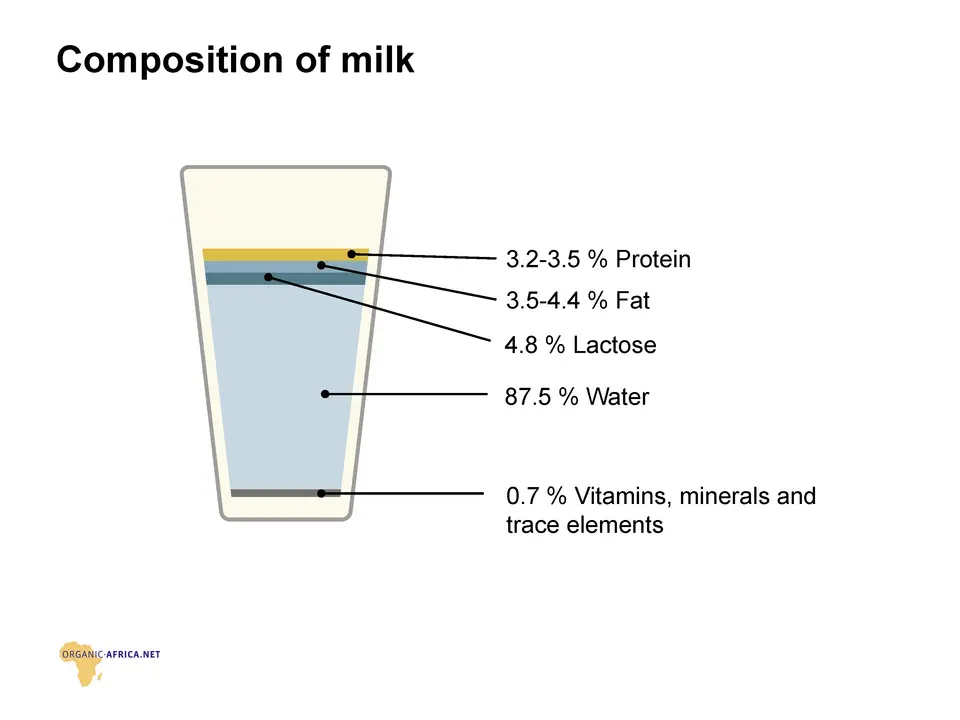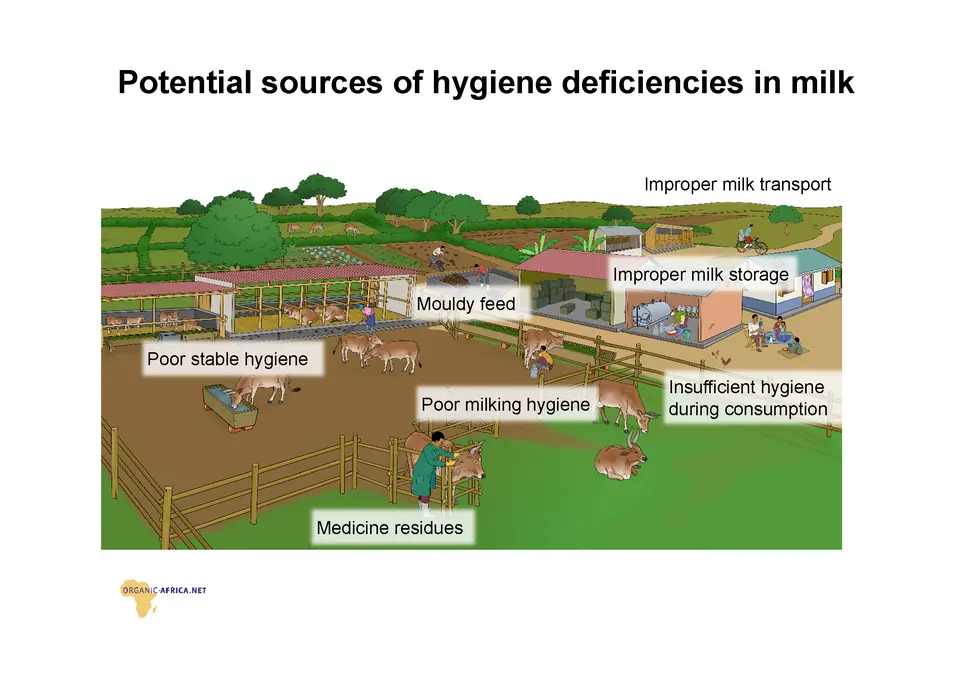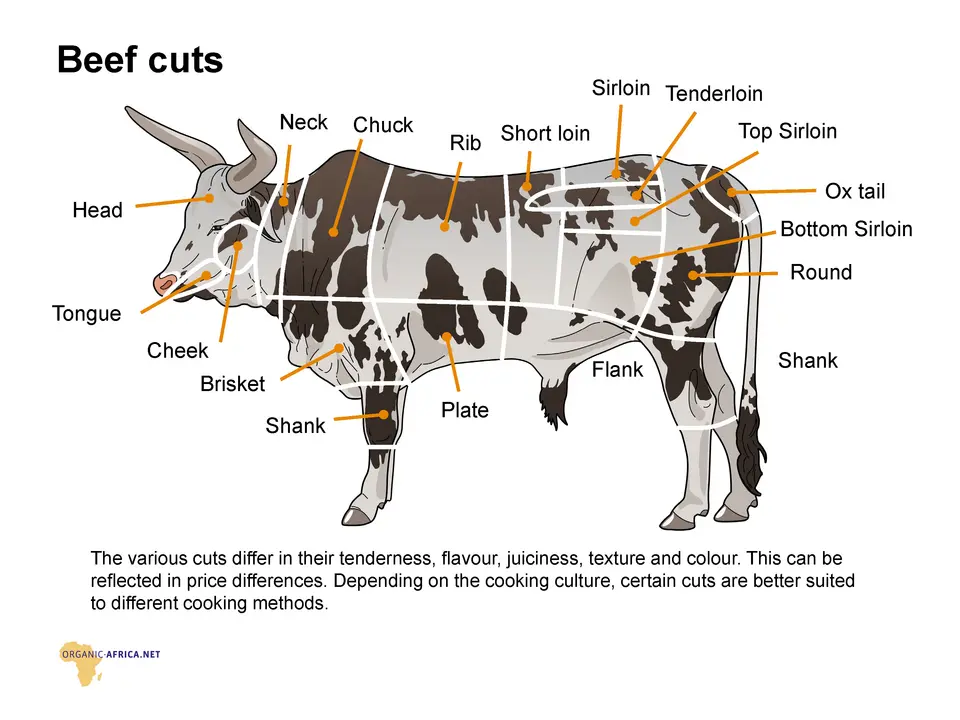Milk and Meat Quality
Characteristics of milk
Milk quality
The quality of milk can vary and has an impact on the safety for consumption, the suitability of the milk to be processed or stored, and sometimes on the milk price. Key indicators for milk quality are:
- Fat and protein content: While the content of lactose is constant, the fat and protein content can vary and has an impact on the taste and the amount of cheese that can be produced with that milk. Fat and protein contents can vary between different breeds and are also influenced by the feed. Sometimes, milk producers mix milk with water to increase the quantity. This also decreases the content of fat and protein in the milk and is generally not acceptable for milk buyers, consumers and law.
- Bacterial count: The bacterial count is an indicator for production hygiene. With good production hygiene 15`000 cells/ml milk or less can be reached. If the bacterial count is too high (usually over 100,000 cells/ml), the suitability for storage, processing, and consumption is lowered. To determine the bacterial count, a sample can be tested in a laboratory or on the farm using a rapid test. In some countries there are regulations and standards for the bacterial count, and the price that buyers pay farmers for milk also depends on the bacterial count. Other terms used for “bacterial count” are: Total Plate Count (TPC), Total Bacterial Count (TBC), Colony-Forming Units (CFUs).
- Somatic cell count (SCC): SCC measures the number of somatic cells. Somatic cells primarily consist of epithelial cells from the udder and immune cells. Elevated SCC may indicate mastitis or other health issues in the cow and may have implications for milk quality and shelf life. High cell counts do not impact the safety of consumption. In some countries, regulations and standards are in place for the SCC. Some milk buyers use the SCC to determine the milk price.
- Contamination: Residues of medications in milk can occur during the administration of medications to the cow and some days after. The time recommended on the package insert for administering the medication and the waiting time afterwards until the milk can be consumed again must be observed.
Why is hygiene important?
Some of the risks associated with milk consumption include the transmission of infectious diseases such as brucellosis, tuberculosis, and listeriosis. Additionally, milk can be contaminated with harmful bacteria such as E. coli and Salmonella, which can cause food poisoning and other illnesses. There are different ways in which bacteria can get into the milk: via the feeding of the dairy cow, via drug treatments, poor stable hygiene, poor milking hygiene or improper processing and storage of the milk. The following section describes the individual risk factors and explains what can be done to prevent them.
Feeding
Moulds can produce toxic substances called mycotoxins. If mycotoxins are eaten by the cow, this can have enormous consequences for health and fertility of the animal and, in addition, they can contaminate the milk, which is hazardous to health when consumed by humans. It is therefore essential to prevent feed stocks from becoming moldy. Silage or hay harvested late or fodder stored in damp places are particularly susceptible to this. Spoiled fodder must not be fed to animals, but should be composted instead.
Detection of mould: Grain, corn, hay or silage, in particular, can be affected. The forage shows white, black, bluish or reddish discolourations. Hay is often dusty and the stalks have small black spots. The smell is musty. Silage is often white-gray in colour, and corn and grain have white-black down (fluffy coating).
Prevention of mould: Already at the time of cultivation, care should be taken to use suitable varieties and the right time for harvesting. Silage should not be contaminated with soil, not too moist and well compacted. Hay, grain or corn should be dried well before storage, and then stored in a completely dry, well-ventilated and clean place without rodents.
Residues
In organic agriculture, antibiotics cannot be used for the prevention of diseases or as growth promoters. But if an animal is sick, the use of medical treatments such as antibiotics might be necessary to avoid suffering or death of the animal. As residues of antibiotics are found in the milk of the cow, the milk should not be consumed by humans during the treatment and several days after the treatment, depending on the medicine. Antibiotics must always be applied according to the veterinarian’s instructions in terms of quantity and duration. For organic production, withholding periods of double the prescribed length are required to ensure that there are no antibiotic residues in the products.
Hygiene
The stables and especially the lying areas should be cleaned at least twice a day. Dirty stables, enclosures or pens lead to dirty animals, which increases the risk of contamination during milking and also of sick animals.
Milking process
Adhering to a recommended milking process is essential to minimising the risk of pathogens entering the udder and of milk contamination. For milking and the storage of milk, aluminium or stainless steel containers (not plastic containers!) should be used.
After use, the milk containers should be cleaned immediately; first rinsed with clean water, then scrubbed with detergent/soap (alkaline), and afterwards rinsed with hot water and an acceptable sanitising agent (should be acid like e.g. phosphoric acid). The container can also be sterilised with hot water. The water should be as hot as possible (near boiling point) and applied for more than one minute. The container must be too hot to touch. Then the container is placed upside down or hung to dry.
Milk storage
For storage, containers should be used that are easy to wash (with no sharp angled corners) and of aluminum or stainless steel. The milk should be strained right after milking into the storage container, closed or covered, and stored in a cool, clean room. The filter cloth used for straining must be washed immediately after being used. If the milk is stored, it must be placed in a refrigerator. Milk gets sour after 4 to 6 hours if not cooled. Wrapping the milk cans with wet cloths helps to cool them down for a short time, e.g. during transportation.
Pasteurisation is a process of heating raw milk to a specific temperature for a certain period of time to kill any harmful bacteria present in the milk. One common method is to heat the milk to a temperature of 63 to 65°C for 30 minutes, followed by rapid cooling to 4°C or below. Another method is to heat the milk to a temperature of 72°C for 15 seconds, followed by rapid cooling to 4°C or below. Both methods can be done using a simple pot or container over a stove or fire. It is important to note that milk should be pasteurizsed as soon as possible after milking to ensure its freshness and prevent the growth of harmful bacteria. It is also important to use clean utensils and containers when handling milk to prevent contamination.
Consumption of milk
Milk that is safe for human consumption does not contain any physical contaminants, is white (not yellowish white), smells fresh, has no lumps, does not contain any medical residues (e.g. antibiotics) or residues from pesticides and does not contain toxic substances (e.g. aflatoxins). Boiling or pasteurising raw milk before consumption helps reduce the risk of bacterial contamination. The nutrients in the milk are not destroyed by boiling. The milk itself must be boiled to kill the bacteria, whereas drinking milk mixed with boiled water does not adequately kill the bacteria!
Beef meat
The makeup of a specific piece of meat varies depending on the cut. It generally has high levels of proteins, fats, minerals and vitamins. The proteins found in animal products such as meat (or eggs) is particularly valuable for human nutrition. The high fat content makes beef an energy-rich food. Beef contains minerals important for humans, especially iron, zinc and selenium. It also contains many healthy vitamins, for example, many B vitamins. Liver contains a lot of vitamin C, which promotes the absorption of iron, and a lot of vitamin A. Pregnant women should not eat beef liver in the first trimester of pregnancy, as too much vitamin A intake can be harmful to the unborn child. Additionally, beef can contain relatively high levels of saturated fatty acids, which can have negative effects on health if consumed in excess.
Meat quality
It must be considered that the perception of what “good quality meat” is varies a lot between different cultures and people. Nevertheless, it should always be safe to consume, meaning that it is not contaminated or foul.
Meat quality can be evaluated with the following parameters: appearance, marbling*, colour, texture and tenderness, juiciness, odor, pH level, and taste.
*Marbling refers to the intramuscular fat content within the meat. More marbling is generally associated with higher-quality beef, as it contributes to tenderness, juiciness, and flavour.
Factors affecting meat quality:
- Breed: Different cattle breeds are known for producing meat with distinct characteristics. The meat of some breeds is prized for its marbling, tenderness, and flavour, while other breeds are known for their lean meat.
- Genetic selection: Breeding programs can select for specific traits, including marbling, which plays a significant role in beef quality.
- Age: Young bulls have a comparatively low fat content in their meat compared to meat from animals slaughtered when they are older. Younger animals, regardless of sex, typically produce more tender meat with milder flavours.
- Sex: Generally, beef from oxen (castrated males) and heifers (females that have not calved) is preferred for tenderness. This is because these animals typically have less connective tissue in their muscles compared to bulls (intact males). Some consumers prefer the flavour of beef from bulls because it can have a more pronounced and robust taste compared to the milder flavour of beef from oxen and heifers.
- Feeding: The diet of cattle, especially in the final stages before slaughter, can influence meat quality.
- Stress: Proper handling and low-stress environments are essential to prevent meat quality degradation. Stress can lead to toughening of the meat due to the release of stress hormones.
- Cuts: Different cuts of beef have varying qualities and are suited to different preparation methods. For example, ribeye and filet mignon are known for tenderness, while brisket benefits from slow cooking to tenderize.
- Preservation: To prevent bacterial growth in meat, various preservation methods can be applied: Refrigeration, freezing, curing/salting, smoking, drying or canning.
- Storage: If meat is not stored properly, its shelf life shortens quickly. Fresh meat should be stored in freezers or refrigerators. Without refrigeration or cooling, meat should be preserved by curing, drying, smoking and/or canning.
- Cooking: The cooking temperature and method can impact the final meat quality.
- Processing: Proper handling, aging, and butchering practices are critical to preserving meat quality.
- Hygiene: Proper handling and sanitation throughout the supply chain are essential to maintain the safety and quality of beef. Adequate packaging and storage conditions are crucial for preserving meat quality and preventing spoilage or off-flavors.



 tap and then scroll down to the Add to Home Screen command.
tap and then scroll down to the Add to Home Screen command.